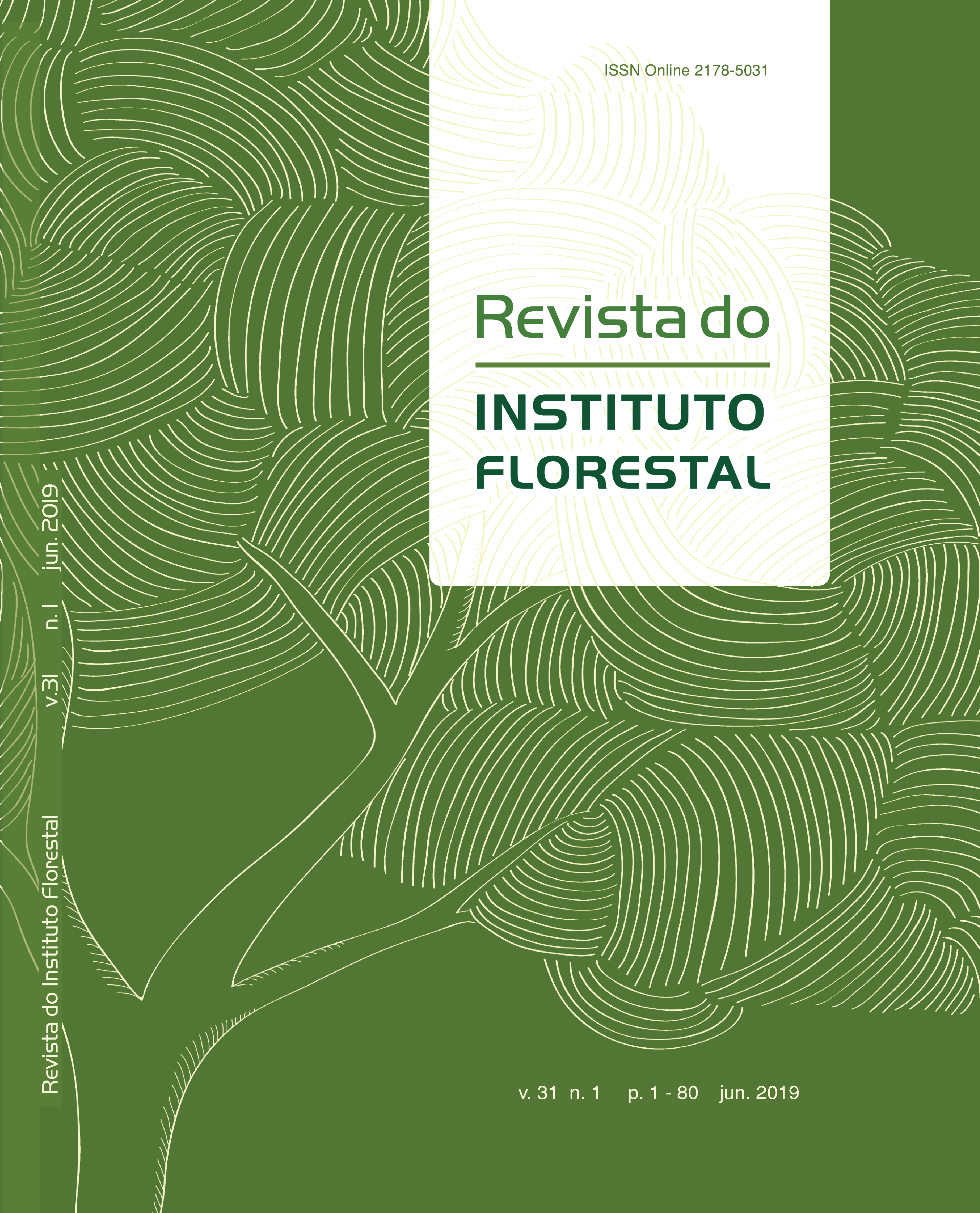GRADIENTES DE UMIDADE E SUAS IMPLICAÇÕES NAS TENSÕES DE SECAGEM, QUANTIDADE E DIMENSÕES DE RACHADURAS NA MADEIRA DE Eucalyptus tereticornis AOS 15 ANOS
DOI:
https://doi.org/10.24278/2178-5031.201931106Keywords:
Moisture content, drying rate, drying defectsAbstract
The moisture gradient, which corresponds to the humidity difference between the center and the periphery of the piece of wood plays an important role in the development of stresses that cause defects such as cracking, hardening and warping. Care to reduce this difference during and at the end of the drying process are important procedures so that the quality of the wood is not compromised. The present work had as the objective of this study was to evaluate the effect of the moisture gradient on the development of stresses of drying Eucalyptus tereticornis wood conducted in a conventional greenhouse. For 40 x 10 x 70 mm boards were then dried at temperatures of 45oC, 60oC and 75oC, from green to a moisture content of 12%. At the end of the drying, the quality was evaluated. through the moisture gradient, drying stresses and defects. The temperature 75ºC provided shorter drying time, but higher moisture gradients, higher tensions and lower wood quality at the end of drying. The temperatures of 60ºC and 40ºC showed great difference in drying time, but humidity gradients very similar and quality of the final material as well. One can then suggest that it be 60ºC for drying Eucalyptus tereticornis wood with gain in time and quality very close to that provided by low temperatures.
Downloads
References
ALVARADO, C. R.; ALVARADO, C. A.; MENDOZA,O.O. Eucalyptus tereticornis Sm: Part II-Species Descriptions. Tropical Tree Seed Manual. 2003. p.470-472.
ANDRADE, A; JANKOWSKY, I.P.; DUCATTI, M.A. Grupamento de madeiras para secagem convencional. Scientia Florestalis , n . 59, p . 89 - 99, jun. 2001.
ASSOCIAÇÃO BRASILEIRA DE NORMAS TÉCNICAS - ABNT. NBR 7190: Projeto de estruturas de madeira. Rio de Janeiro, 1997.73
BARBOSA, C. G. et al. Elaboração de programa de secagem para madeiras de clones de híbridos de Eucalyptus spp. Cerne, v. 11, n. 1, p. 40-48, 2005.
BATISTA, D.C.; KLITZKE, R.J.; ROCHA, M.P. Qualidade da secagem convencional conjunta da madeira de clones de três espécies de Eucalyptus sp. Ciência Florestal, v. 25, n.3, p. 711-719, 2015.
BRANDÃO, A. de O. Determinação de metodologia para a identificação de programas de secagem de madeiras. 1989. 100 f. Dissertação (Mestrado em Ciências Florestais) – Escola Superior de Agricultura “Luiz de Queiroz”, Universidade de São Paulo, Piracicaba.
CINIGLIO, G. Avaliação da secagem de madeira serrada de E. grandis e E. urophylla. 1998. 69f. Dissertação (Mestrado em Ciências Florestais) – Escola Superior de Agricultura Luiz de Queiroz, Universidade de São Paulo, Piracicaba.
DELUCIS, R. A. et al. Propriedades Físicas da Madeira Termorretificada de Quatro Folhosas. Floresta e Ambiente, v. 21, n. 1, p. 99-107, 2014.
DENIG, J.; WENGERT, E.M.; SIMPSON, W.T. Drying hardwood lumber. Gen. Tech. Rep. FPL–GTR–118. Madison, WI: U.S. Department of Agriculture, Forest Service, Forest Products Laboratory. 2000. 138 p.
GALVÃO, A. P.M.; JANKOWSKY, I.P. Secagem racional da madeira. São Paulo: Nobel, 1985. 111 p.
KLITZKE, R. J.; BATISTA, D. C. Ensaio de taxa de secagem e escore de defeitos para a predição da qualidade de secagem convencional da madeira de Eucalyptus. Scientia Forestalis, v. 38, n. 85, p. 97-105, mar. 2010.
MARTINS, V.A. Secagem de madeira serrada.Brasília: IBDF, 1988. 56p.
OLIVEIRA, L. C. S. Perguntas e respostas em secagem de madeiras. São Paulo: IPT, 1981. 36p.
PONCE, R.M.; WATAI, L.T. Manual de secagem de madeira. Brasília: MIC/STI/IPT, 1985. 70 p. (Série Documentos, 22).
REZENDE, R. N. et al. Efeito da vaporização na secagem de tábuas de Eucalyptus grandis. Cerne, v. 21, n. 1, p. 37-43, 2015.
ROCHA, M. P. Eucalyptus grandis Hill ex Maiden e Eucalyptus dunnii Maiden como fontes de matéria prima para serrarias. 2000. 185 f. Tese (Doutorado em Ciências Florestais), Universidade Federal do Paraná, Curitiba.
SANTINI, E. J. Influência de temperatura na taxa de secagem e contração da madeira de Pinus elliottii proveniente de plantios de rápid crescimento. Curitiba: FUPEF, 15p. (Série Técnica, 5), 1980.
SANTOS, G. R. V.; JANKOWSKY, I. P.; ANDRADE, A. Curva característica de secagem para madeira de Eucalyptus grandis. scientia Forestalis, n. 63, p. 214-220, 2003.
SILVA, J. C. Eucalipto: a madeira do futuro. Revista da Madeira, Edição especial, 2001. 114 p.
SIMPSON, W. T. Dry kiln operator’s manual.
Madison: U.S. Department of Agriculture, Forest Products Laboratory, 1991. 274 p.
SOUZA, J.T. et al. Qualidade da madeira serrada proveniente de árvores dominantes 167 e médias de Eucalyptus grandis submetidas à secagem.Cerne, v. 18, n. 1, p. 167-174, jan./mar. 2012.
STANGERLIN, D. M. et al. Uso de estufa solar para secagem de madeira serrada. Ciência Florestal, v. 19, n. 4, p. 461-472, out/dez. 2009.
TOMASELLI, I. Secagem de madeira. Curitiba:FUPEF, 1980. 29 p.
VIDAURRE, G. et al. Lenho Juvenil e Adulto e asPropriedades da Madeira. Floresta e Ambiente,v. 18, n. 4, p. 469-480, out./dez. 2011.
















